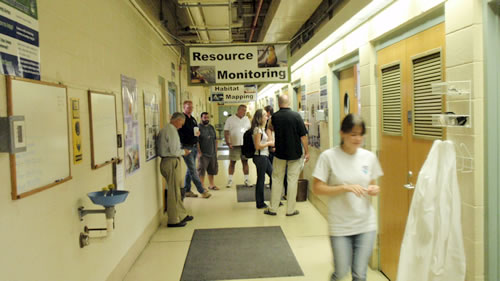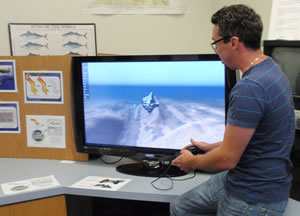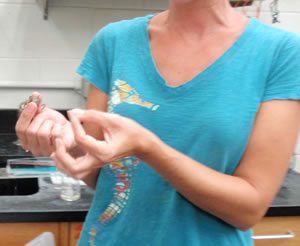Feds Propose Closure of Crucial NOAA Fisheries Lab
By Jennifer MacGregor and Lydia Liebman

Scientists explain happenings at Sandy Point Lab to Education Update.
The James J. Howard Marine Sciences Laboratory, strategically nestled in the Gateway National Recreation Area on Sandy Hook, N.J., and partially housed in an old Army barracks, has been conducting research for 50 years that is vital to the community at large. Despite the contributions the lab has made to the knowledge we have of the mid-Atlantic ecosystem, the lab is in danger of closing due to proposed cuts in the federal budget for 2013.
 Video game teaches biology.
Video game teaches biology.
The lab’s unique location at Sandy Hook, which is a barrier spit that separates Lower New York Bay from the Atlantic Ocean, is the only maritime research center that is located directly downstream from the largest population center in the U.S.
Dr. Thomas T. Noji, the director of the lab, said that the Marine Sciences Laboratory studies five key topics: climate change, habitat mapping, marine contaminants, ocean acidification and resource assessment.
“Our contribution to fisheries science of the northeast is to look at the effects of environment on marine biota,” Noji said. “We’re not out there counting fish, but what we do understand better than most is how important habitat — and how important ecosystem integrity — is for everything out there in the ocean.”
Lab scientists explained that the research they conduct is essential for the study of the region’s marine life. The lab has done critical studies on toxicity and pollutants in the water, as well as helping commercial and sport fisherman predict where populations of fish will be.
 Sea crab experiment.
Sea crab experiment.
Lab scientists explained that the research they conduct is essential for the study of the region’s marine life. The lab has done critical studies on toxicity and pollutants in the water, as well as helping commercial and sport fisherman predict where populations of fish will be.
The lab plays an integral role in the community of Sandy Hook. Students from the nearby Marine Academy of Science and Technology not only have access to scientific equipment in the lab, but are able to perform experiments that most high school students would never have the chance to do.
Some MAST students even have an opportunity to complete a paid internship at the lab. One student, Shaina Villalobos, just graduated from MAST and is helping out with research and fish maintenance this summer.
Dr. Christopher Chambers, a research fishery biologist and also the co-leader of SHIP, the Sandy Hook Internship Program, said that the lab was custom-built around the 32,000-gallon tank that currently holds black sea bass. Sandy Hook is the only lab in the country that has a tank of this size used for research purposes.
The dark room that encompasses the tank has an arch of computer-controlled fluorescent lighting overhead that can be programmed to simulate the sunrise and sunset. The scientists are able to trick the fish into thinking it’s a different time of year than it really is, Chambers said.
Dr. Richard Langton, the chief of coastal ecology, said that his research focuses on identifying areas in the ocean where fish and coral species are likely to occur, based on the temperature, depth and salinity of the water. Researchers are then able to go to those areas where there’s a high probability of finding these species of fish and deep-water corals.
Langton said that one of the goals of the lab’s research is to advise when to close areas to commercial fishing. Research the lab has done was directly responsible for elimination of dredging of the ocean floor in the tri-state area, due to the negative effect it was having on the winter flounder population.
Steven Fromm, who specializes in habitat research and assessment, said one of the most important studies the lab has been involved in was providing research that proved sewage dumping was having a negative effect on the ecosystem — and the health of everyone along the coast from Boston to Washington, D.C.
The lab offers tours to school and professional groups, allowing visitors to wind through their hallways and talk to the various scientists about their research.
Overhead signs indicate what is studied in each area of the lab. In the ocean acidification section Dr. Allison Candelmo, a postdoctoral researcher at the lab, focuses on how changes in ocean pH levels affect marine life, specifically the larvae, eggs, and gametes of flounder.
